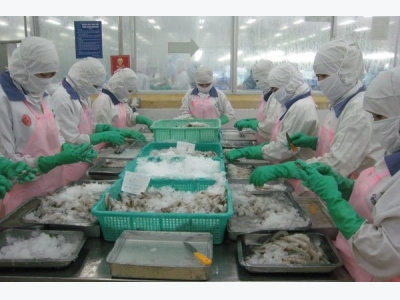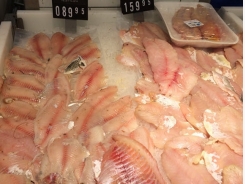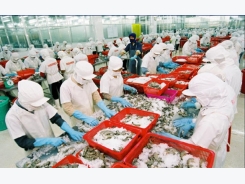EU inspects Vietnamese shrimp export enterprises

Workers process shrimp for export - PHOTO: TRUNG CHANH
HCMC - Inspectors of the European Union (EU) have examined several shrimp exporters in Bac Lieu and Ca Mau provinces due to doubts about the designation of origin, said Tran Thanh Hai, deputy director of the Import-Export Department under the Ministry of Industry and Trade.
"Since Vietnam enjoys preferential tariffs, EU countries require us to guarantee the Vietnamese origin of products exported to them," Hai explained at the 2017 annual economic forum held by Can Tho People's Committee on April 13.
Currently, EU import tariffs for Vietnam's shrimp are much lower than those for India. Specifically, the tariff for unprocessed shrimp imports from Vietnam is 4.2%, compared to 12% for India. For semi-processed shrimp, Vietnam enjoys a tax rate of about 7% while that of India is 20%.
The EU side suspected that Vietnamese enterprises may have imported shrimp from India and then shipped it to the EU. Therefore, EU inspectors have inspected some shrimp facilities in Bac Lieu and Ca Mau, two major shrimp farming provinces of Vietnam, during the past two weeks.
Hai advised shrimp export enterprises to pay close attention to the EU requirements for designation of origin. "To export products to the EU, enterprises must ensure food hygiene, safety and origin. Although this is a common requirement of other choosy markets such as the United States and Japan, the EU’s requirements are most stringent," Hai said.
Speaking to the Daily after the conference on implementation of shrimp production plan in 2017 held in Soc Trang Province on March 23, Deputy Minister of Agriculture and Rural Development Vu Van Tam said that the EU was suspicious of the fraudulent designation of origin of Vietnamese shrimp and some other seafood products.
However, according to Tam, the Ministry of Agriculture and Rural Development has written to the EU affirming that there is no circumvention of Vietnam shrimp trade to the EU. "We are ready to meet the EU inspection team and Vietnam won’t let the benefits of a few businesses affect the prestige of Vietnam’s fishery industry," said Tam.
Seafood exports face multiple technical barriers
A number of countries have issued regulations which Vietnamese enterprises see as technical barriers to their exports, said the Department for Animal Health at the Ministry of Agriculture and Rural Development.
Shrimp exports to Australia are put into two categories: uncooked and cooked, said the department.
Uncooked shrimp must be sourced from nations and territories recognized by Australian authorities as being free from such diseases as white spot, yellow head, hepatic necrosis due to bacteria and acute hepatic necrosis. In addition, they should be beheaded, peeled and marinated in accordance with the provisions for use as food for humans.
Meanwhile, cooked shrimp must be certified by the export authority that this item is eligible as human food, be monitored during processing and display no signs of contagious disease.
As such, a shrimp product that has not yet been cooked is licensed by Australia and one that has been cooked is approved by the competent authority of the exporting country.
Meanwhile, in South Korea, farmed or marine fish when shipped to this market must be permitted by the competent authority of the exporting country. These include frozen and chilled shrimp, except peeled and beheaded shrimp, frozen oysters and mollusks, even hand-carried items.
The Korean authority will automatically take samples to check whether the products meet the requirements of the World Organization for Animal Health (OIE) for shrimp. Such a regulation came into force on April 9, 2017.
Therefore, for uncooked shrimp, the rules of Australia and South Korea are almost opposite. Exports to Australia are inspected and certified by this country, while exports to South Korea are examined by the exporting country, which is the National Agro-Forestry-Fisheries Quality Assurance Department (NAFIQAD) in the case of Vietnam.
China also has requirements for surveillance and sampling for testing for pathogens on live shrimp. Other markets such as Saudi Arabia, Russia, Brazil and Mexico have set specific regulations for shrimp imports into these countries, said the Department for Animal Health.
Although technical barriers vary among nations, shrimp exporters must comply with all regulations of the import markets. Therefore, when exporting to different markets, enterprises should pay attention to such rules, said the department.
The Department for Animal Health advised seafood exporters to grasp the OIE regulations, or the provisions of the WTO Agreement on the Application of Sanitary and Phytosanitary Measures (SPS Agreement) and of other countries, to have appropriate plans for product development meeting the technical standards of each market.
Related news
Tools

Phối trộn thức ăn chăn nuôi

Pha dung dịch thủy canh

Định mức cho tôm ăn

Phối trộn phân bón NPK

Xác định tỷ lệ tôm sống

Chuyển đổi đơn vị phân bón

Xác định công suất sục khí

Chuyển đổi đơn vị tôm

Tính diện tích nhà kính

Tính thể tích ao




 Ministry moves to tackle aquatic animal diseases
Ministry moves to tackle aquatic animal diseases  Export turnover to Switzerland sharply increased
Export turnover to Switzerland sharply increased